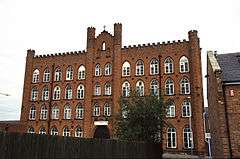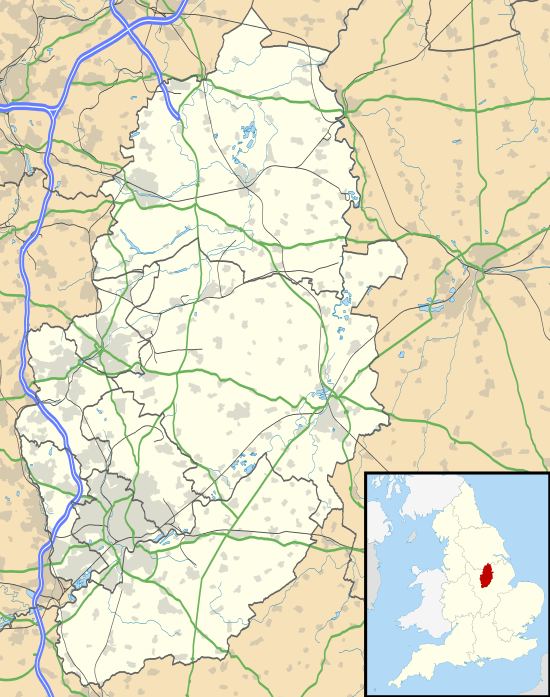Anglo Scotian Mills
The Anglo Scotian Mills is former lace factory in Beeston, Nottinghamshire. It is a Grade II listed building.[1]
| Anglo Scotian Mills | |
|---|---|
 Anglo Scotian Mills, Beeston | |
 Location within Nottinghamshire | |
| General information | |
| Architectural style | Crenellated Gothic |
| Location | Wollaton Road, Beeston |
| Town or city | Nottingham |
| Country | England |
| Coordinates | 52.929628°N 1.217463°W |
| Completed | 1892 |
| Client | Francis Wilkinson |
| Design and construction | |
| Architect | James Huckerby |
History
The firm was established by Francis Wilkinson (1846-1897) in the 1870s in Beeston. The original mill buildings were destroyed by a fire on 29 April 1886.[2] The falling walls of the mill destroyed several cottages and the damage was estimated at £300,000 (equivalent to £32,920,000 in 2019).[3] Six years later, on 30 April 1892, another fire broke out which destroyed the mill.[4] The damage this time was estimated at £100,000 (equivalent to £10,950,000 in 2019).[3]
The current building was erected on Wollaton Road, Beeston in 1892. The architect was James Huckerby of The City, Beeston. In 1893, as a consequence of the strike by coal miners at Wollaton, Trowell Moor and Clifton, the mill owners were forced to reduce their operating hours to eight per day to conserve stocks of coal[5] which consequently reduced the wages paid to 1,000 workers.
On the death of Francis Wilkinson in 1897, the business was taken over by his older brother George Wilkinson until 1909 when the factory was sold to the owners of the nearby Swiss Mills. The new owners, the Pollard family, let lace machine standings and a cotton store to Parkes & Tomlin[6] and eventually Parkes purchased it in 1922.[7]
In the 1960s, the building was used for the manufacture of electrical components, until this business collapsed in 2003.[8]
Following the collapse of the business, the buildings were converted for residential use.
References
- Historic England. "Details from listed building database (1263854)". National Heritage List for England. Retrieved 22 April 2015.
- "Local and Domestic Fields". Nottingham Journal. England. 30 April 1886. Retrieved 15 September 2019 – via British Newspaper Archive.
- UK Retail Price Index inflation figures are based on data from Clark, Gregory (2017). "The Annual RPI and Average Earnings for Britain, 1209 to Present (New Series)". MeasuringWorth. Retrieved 2 February 2020.
- "Latest Particulars". Nottingham Evening Post. England. 30 April 1892. Retrieved 15 September 2019 – via British Newspaper Archive.
- "Beeston". Nottingham Journal. England. 1 September 1893. Retrieved 15 September 2019 – via British Newspaper Archive.
- Pollard, E. Pollards of Beeston, 2006
- Nottingham Industrial Archaeology Society Journal. Vol 10, part 2, Mar 1985
- A History of Beeston Lace, Professor Stanley Chapman, University of Nottingham.